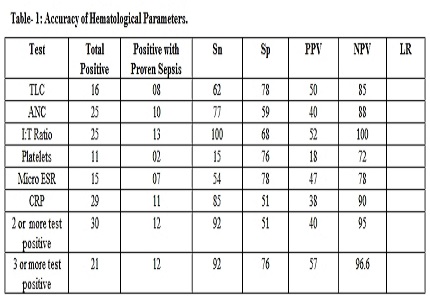A comparative study of CBP, CRP, Micro ESR and blood culture in the diagnosis of neonatal septicemia
Abstract
Background: Neonatal sepsis is one of the most important causes of morbidity and mortality in children. The incidence was 3% in intramural births, with an overallmortality rate of variation of 18.6%.
Aims and Objectives: To evaluate the role of blood culture, micro ESR, CBP, CRP in the diagnosis of sepsis in children. To study sensitivity, specificity, positive predictive values and negative predictive values of the above hematological parameters, either individually or in combination with diagnosis of neonatal sepsis.
Method: A study was carried out from January 2015 to December 2015 in hospital, based on, samples of babies with history of infective etiology within the first 28 days of birth.
Result: One hundred neonatal cases of clinically suspected septicemia were studied. Culture positive rate was 26%. E coli was the major organism responsible for early onset of sepsis. The highest sensitivity and negative predictive value was found for septic score of more than or equal to 3 by septic scoring, I:T ratio and C- reactive protein with the highest sensitivity, micro ESR and TLC with the highest specificity.
Conclusion: CRP emerged as the test with the highest sensitivity. Micro- ESR and TLC had the highest specificity.
Downloads
References
2. AnupamSachder, Sunil Sarin, Neonatal Sepsis, Jounal of P.G. Medical Education and Training and Research 36, Vol. 11 No. 1 Jan-Feb 07.
3. National Neonatal and PerinalDatabase, 2002-03.
4.Paul VK, Singh M. Diagnosis and treatment of neonatal sepsis. Indian Pediatr. 1986 Dec;23(12): 1023-35. [PubMed]
5. Gerdes JS, Polin R. Early diagnosis and treatment of neonatal sepsis. Indian J Pediatr. 1998 Jan-Feb; 65(1):63-78. [PubMed]
6. Philip AG, Hewitt JR. Early diagnosis of neonatal sepsis. Pediatrics. 1980 May;65(5):1036-41. [PubMed]
7. Singh M, Narang A, Bhakoo ON. Evaluation of a sepsis screen in the diagnosis of neonatal sepsis. Indian Pediatr. 1987 Jan;24(1):39-43. [PubMed]
8. Joshi SG, Ghole VS, Niphadkar KB. Neonatal gram-negative bacteremia. Indian J Pediatr. 2000 Jan; 67 (1): 27-32. [PubMed]
9. Tallur SS, Kasturi AV, Nadgir SD, Krishna BV. Clinico-bacteriological study of neonatal septicemia in Hubli. Indian J Pediatr. 2000 Mar;67(3):169-74. [PubMed]
10. Nawshad Uddin Ahmed ASM, Chaudhery A, Hogue M, Darmstadt Gill clinical and bacteriological profile of neonatal septicemia in a tertiary level pediatric hospital in Bangladesh Indian pediatric 2001:39:1034-9. [PubMed]
11. Sharma A, Kutty CV, Sabharwal U, Rathee S, Mohan H. Evaluation of sepsis screen for diagnosis of neonatal septicemia. Indian J Pediatr. 1993 Jul-Aug; 60(4):559-63. [PubMed]
12.Rodrigvez- Weber MA, Lopez–Candianic Arrendonlo - Garcia JL el al, Morbidity and morbidity from neonatal bara sepsis in a tertiary care level hospital saludpublica de Nex.co 2003;45(2):1.8. [PubMed]
13. Misra PK, Kumar R, Malik GK, Mehra P, Awasthi S. Simple hematological tests for diagnosis of neonatal sepsis. Indian Pediatr. 1989 Feb;26(2):156-60. [PubMed]
14. Chandana A, Rao NM, Shriniwas M Shyamala S. Rapid diaggonitive tests in neonatal septicemia. Indian. J pedletr 1988,55(5) : 947-50. [PubMed]
15. Bhakoo ON, Singh M. Perinatal risk factors in neonatal bacterial sepsis. Indian J Pediatr. 1988 Nov-Dec;55(6):941-6. [PubMed]
16. Rodwell RL, Leslie AL, Tudehope DI. Early diagnosis of neonatal sepsis using a hematologic scoring system. J Pediatr. 1988 May;112(5):761-7. [PubMed]
17. Namdeo UK, Singh HP, Rajput VJ, Kushwaha JS. Hematological indices for early diagnosis of neonatal septicemia. Indian Pediatr. 1985 Apr;22(4):287-92. [PubMed]
18. Basu S. Gelruprasad,Narang 4, Garcusal G. Diagnosis of Sepsis in the high risk neonate using a hematology scoring System . Indian J Hemat Blood Transf 1999, 17(2) 32-4.
19. Kite P, Millar MR, Gorham P, Congdon P. Comparison of five tests used in diagnosis of neonatal bacteraemia. Arch Dis Child. 1988 Jun;63(6):639-43.
20. Kuruvilla KA, Pillai S, Jesudason M, Jana AK. Bacterial profile of sepsis in a neonatal unit in south India. Indian Pediatr. 1998 Sep;35(9):851-8. [PubMed]
21. Gerdes JS, Polin RA. Sepsis screen in neonates with evaluation of plasma fibronectin. Pediatr Infect Dis J. 1987 May;6(5):443-6. [PubMed]
22. Singh M, Narang A, Bhakoo ON. Evaluation of a sepsis screen in the diagnosis of neonatal sepsis. Indian Pediatr. 1987 Jan;24(1):39-43.
23. Boo NY, Chor CY. Six year trend of neonatal septicaemia in a large Malaysian maternity hospital. J Paediatr Child Health. 1994 Feb;30(1):23-7.
24. Karthikeyan G, Premkumar K. Neonatal sepsis: Staphylococcus aureus as the predominant pathogen. Indian J Pediatr. 2001 Aug;68(8):715-7. [PubMed]
25. Mishra JN, Rai MG, Chakraborty S, Prasad S. Study of neonatal septicemia. Indian Pediatr. 1985 Apr; 22 (4):281-5. [PubMed]

Copyright (c) 2016 Author (s). Published by Siddharth Health Research and Social Welfare Society

This work is licensed under a Creative Commons Attribution 4.0 International License.


 OAI - Open Archives Initiative
OAI - Open Archives Initiative


